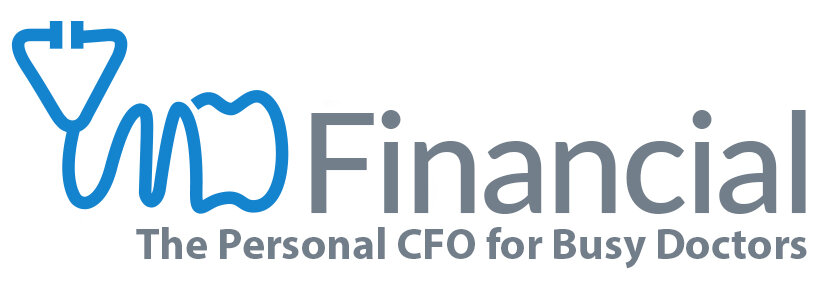By Josh B. Lantz, CRPC®
When it comes to being in debt, you’re not alone. It’s not uncommon for our doctors to have student loans ranging from $200,000 to $400,000, sometimes even more, by the time they become attending physicians or surgeons.
Where do you even begin? Unfortunately, most doctors have the attitude, “If I can only get through medical/dental school and residency, I’ll take care of my loans when I am making a lot of money.” This was a strategy that worked great 30 years ago, when school was cheap, interest rates and taxes were low and in turn, doctors and dentists weren’t saddled with the enormous student loans you have today. Unfortunately, it doesn’t work in today’s reality.
What can you do about it today? There are many possible options, but one that is popular is called Public Service Loan Forgiveness (PSLF.)
“It’s true that PSLF doesn’t work for everyone, however in my experience, most physicians find it suitable for them.”
With PSLF, it is possible to get some of your federal loan indebtedness forgiven. In return for working at a non-profit hospital or clinic and making 120 qualified, monthly student loan payments, the federal government will give you tax-free loan forgiveness on certain Federal loans.
If you use this special repayment program to make 120 monthly loan payments on Federal Direct loans, while working at a non-profit organization, then the balance of any interest or principal that is still outstanding at the end of the 10 years, will be forgiven.
There are certain requirements to make this program work for you. Physicians and Dentists who want to do PSLF need to sign up for either Income Based Repayments (IBR), Pay as Your Earn (PAYE), or Revised Pay as Your Earn (REPAYE). IBR, PAYE, and REPAYE are federal repayment programs that keep your payments affordable during your training. While IBR is a good program, PAYE is less expensive, so if you qualify, PAYE should likely be your first choice with a few rare exceptions. For a more detailed description check here.
PSLF is very important to many physicians. It is less likely to work for dentists since few of our dental clients end up working for a not-for-profit. To illustrate what this means on a personal level, let me give you an example: I was working with a family medicine doctor recently who had $230,000 in student loans. His intention was to work in residency at a non-profit for three years and then go into practice, also working at a local non-profit once in practice. Repaying his loans in the old-fashioned way, this doctor would have paid more than $313,000 over ten years. But by choosing to use IBR, he would only pay $172,000, or even better, only $115,000 under PAYE. This decision will be saving him $141,000 through IBR and $198,000 with PAYE. Those are some significant savings!
On top of that, remember the PSLF forgiveness is tax-free compared to other loan forgiveness programs that are taxable. Normally the IRS considers any loan that is forgiven to be phantom income that is taxable in the year it is forgiven. The fact that this is not a taxable event for doctors in the PSLF program is another big plus. For instance, if at the end of 10 years, you still owe $200,000 on your loan and all $200,000 is forgiven, that would normally mean you would have to pay income tax on $200,000. In some high tax states, that could mean almost 50% in taxes. In other states it could still be 33%, or close to $70,000! So the tax savings are a big part of this program.
There are a few qualifiers that are important to note, however. First, you need to make sure the 120 payments are made using one of the federal repayment programs like IBR, PAYE, or REPAYE. Second, PSLF only works for certain types of Federal student loans, so if you have FFEL loans make sure you consolidate them to Direct Federal loans. PSLF doesn’t work for private loans. Third, while PAYE saves you more money than IBR, not everyone qualifies for PAYE. Whether you qualify for PAYE depends on when your federal loans were disbursed to you (details here). Which program (IBR, PAYE, REPAYE) to select is beyond the scope of this article and you should contact us with questions.
It’s true that PSLF doesn’t work for everyone, however in my experience, a lot of physicians find it suitable for them. Although there are some of the factors to consider: specialty, loan type, loan balance, future income, and future employer. Here’s some more information on each:
Specialty: certain specialties tend to work best in private practice environments. Given PSLF only works for non-profits, this means you can’t get the loan forgiveness done while in residency and fellowship under the 10-year rule. With that in mind, this program typically does not work for our radiologists, orthopedic surgeons, orthodontists, endodontists, or other high-earning specialties. As a result, many of these specialties choose to pay off their loans the traditional way - they put them in forbearance until they finish their training and then they choose either a 10 or 15-year payback, often after refinancing.
Loan Type: remember only certain types of Federal loans qualify for PSLF. If you have a lot of private loans this strategy might not work as well for your situation.
Loan Balance: the higher your loan balance the better the PSLF program tends to work for you. If you are only going to have $40,000 dollars in student loans when you go into practice, it might not be worth restricting your employment options to non-profit work to qualify for the program.
Future Income: IBR, PAYE, and REPAYE are income-based repayment programs. As a result, the higher your income the larger your payments. For example, take an anesthesiologist making $250,000 their first year compared to a pediatrician making $130,000. The pediatrician will get a much larger reduction in their payments and thus pay less over time than the anesthesiologist. Each situation is unique of course, but in general these programs favor lower paying specialties.
Future Employer: you are only going to be able to knock out part of the ten repayment years for PSLF while you are in your training, even if you use some of those years for fellowship. You need to think in terms of whether you can finish the remaining years at a non-profit. A non-profit might be the Veterans Administration, a university, or a non-profit hospital/clinic.
As you can see, many of the decisions involved are complex and take several years of planning. The earlier you can start strategizing the better, but if one of these options works for you it can end up saving you thousands of dollars over time.
We frequently devise personalized debt plans for our clients, running the numbers so that they can make good choices. Feel free to reach out to us if you have any questions about whether these loan repayment programs will work for you or if you need a second opinion on your current debt strategy.
Josh B. Lantz, CRPC®, is the Chief Investment Officer and a financial advisor at MD Financial (www.MDFinancialAdvisors.com), a firm that does comprehensive financial planning for physicians and dentists across the country. He can be reached at 888-256-6855, Josh@MDFinancialAdvisors.com


